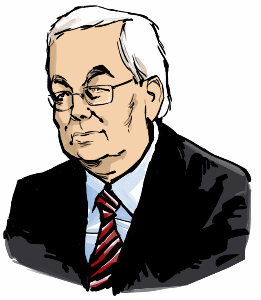© Gunnar Tómasson
10 February 2016
The Man Who Saw Through Time
(Loren Eiseley)
Not all men are fated like Sir Francis Bacon, to discover an unknown continent, and to find it not in the oceans of this world but in the vaster seas of time. Few men would seek through thirty years of rebuff and cold indifference a compass to lead men toward a green isle invisible to all other eyes. “How much more,” he wrote in wisdom, “are letters to be magnified, which as ships pass through the vast seas of time, and make ages so distant to participate of the wisdom, illumination, and inventions, the one of the other…..” “Whosoever shall entertain high and vaporous imaginations,” he warned, “instead of a laborious and sober inquiry of truth, shall beget hopes and beliefs of strange and impossible shapes.” It is ironic that Bacon, a sober propounder of the experimental method in science – Bacon, who sought so eloquently to give man control of his own destiny – should have contributed, nevertheless, to that world of “impossible shapes” which surrounds us today.
Appropriately there lingers about this solitary time voyager a shimmering image of fable, an atmosphere of mystery, which frequently closes over and obscures the great geniuses of lost or poorly documented centuries. Bacon, who opened for us the doorway of the modern world, is an incomparable inspiration for such myth-making proclivities. Rumors persist that he did not die in the year 1626 but escaped to Holland, that he was the real author of Shakespeare’s plays, that he was the unacknowledged son of Queen Elizabeth. Rumor can go no further; it is a measure of this great discoverer’s power to captivate the curiosity of men – a power that has grown century by century since his birth in 1561. In spite of certain mystifying aspects of his life, there is no satisfactory evidence sufficient to justify these speculations, though a vast literature betokens their fascination and appeal. (The Man Who Saw Through Time, Revised and enlarged edition of Francis Bacon and the Modern Dilemma, Charles Scribner’s Sons, New York, 1973, pp. 49-50)
A Beam of Knowledge Derived from God
(Francis Bacon’s Personal Chaplain)
“I have been induced to think, that if there were a Beam of Knowledge derived from God upon any Man in these Modern Times, it was upon him; for though he was a great Reader of Books, yet he had not his Knowledge from Books, but from some Grounds and Notions within himself.” (Resuscitatio, 1670, Ed. P. 9. Dr. W. Rawley, for many years his chaplain, secretary and confidant. (Alfred Dodd, Francis Bacon’s Personal Life-Story, Rider & Company, London, 1986, p . 89.)
Bacon, like Moses, led us forth at last
(Catherine Drinker Bowen)
…Thomas Tenison, later Archbishop of Canterbury, in 1679 published a book entitled Baconiana, or Certain Genuine Remains of Francis Bacon. “Such great wits,” wrote the Archbishop, “are not common births of Time. Nature gives the world that individual species, the phoenix, but once in five hundred years…. I do not here pretend to speak of an angel but of a man. And no man, great in wit and high in office, can live free from suspicion of both kinds of errors. For that heat which is instrumental in making a great wit, is apt to disorder the attention of the mind, and the stability of the temper. This Lord’s fall will be to posterity but as a little picture of nightwork, remaining amongst the fair and excellent tables of his acts and works.”
It is pleasant to read the Archbishop, paraphrasing Bacon’s own words in his defense. His fall this lord foresaw, wrote Sir William Dugdale. “Yet he made no shew of a base and mean spirit…. It appeared not by any thing during all the time of his eclipse of fortune, that there was any abjectness of spirit in him.”
Scientific minds were even more lenient to the Lord Chancellor. Robert Hooke mentioned how “poor Galileo was put into the Inquisition…. Thus it happened also to Roger Bacon, and, I am apt to suspect, to the far greater man, the Lord Chancellor Bacon, for being too prying into the then receiv’d philosophy.” Bishop Sprat, in his History of the Royal Society, makes no mention of Bacon’s fall but only of his genius, “searching and inimitable…a man of strong, clear and powerful imaginations.” No further proof was needed, said Sprat, “than his style itself; which as for the most part of it describes men’s minds, as well as pictures their bodies, so did his above all men living… The course of it vigorous and majestical, the wit bold and familiar.”
Abraham Cowley [1618-1667 insert] wrote an ode to the Royal Society, it is often quoted…..
Bacon, like Moses, led us forth at last,
The barren wilderness he past,
Did on the very border stand
Of the blest promis’d land
And from the mountain’s top of his exalted wit,
Saw it himself, and shew’d us it.
(Francis Bacon – The Temper of a Man, Little Brown and Company, Boston, 1963, pp. 229-231)
***
I. Francis Bacon’s Last Letter
Commemorating the Resurrection of Our Saviour
(Alfred Dodd)
Every schoolboy knows the story told in their history books how Francis Bacon one snowy day on or about All Fools Day, 1 April 1626, drove with the King’s Physician, Sir John Wedderburn, to Highgate and that at the foot of the Hill he stopped, bought a fowl, and stuffed it with snow with his own hands in order to ascertain whether bodies could be preserved by cold. During the procedure, we are told, he caught a chill, and instead of Dr. Wedderburn driving him back to Gray’s Inn (whence he had come) or taking him to some warm house, the worthy doctor took him to an empty summer mansion on Highgate Hill, Arundel House, where there was only a caretaker; and there Francis Bacon was put into a bed which was damp and had only been „warmed by a Panne“ (a very strange thing for a doctor to do) with the result that within a few days he died of pneumonia. Dr. Rawley, his chaplain, says that he died „in the early morning of the 9th April, a day on which was COMMEMORATED the Resurrection of Our Saviour“.
That is the story and this is…:
Francis Bacon’s Last Letter
(Easter Week, 1626)
526846
14285 = To the Earle of Arundel and Surrey.
7470 = My very good Lord:
27393 = I was likely to have had the fortune of Caius Plinius the Elder,
19392 = who lost his life by trying an experiment
21445 = about the burning of the mountain Vesuvius.
27312 = For I was also desirous to try an experiment or two,
23426 = touching the conservation and induration of bodies.
27127 = As for the experiment itself, it succeeded excellently well;
19881 = but in the journey between London and Highgate,
18137 = I was taken with such a fit of casting,
20866 = as I knew not whether it were the stone,
24599 = or some surfeit of cold, or indeed a touch of them all three.
19809 = But when I came to your Lordship’s house,
20992 = I was not able to go back, and therefore was forced
10541 = to take up my lodging here,
27187 = where your housekeeper is very careful and diligent about me;
10692 = which I assure myself
24956 = your Lordship will not only pardon towards him,
14898 = but think the better of him for it.
21030 = For indeed your Lordship’s house is happy to me;
18831 = and I kiss your noble hands for the welcome
15120 = which I am sure you give me to it.
30197 = I know how unfit it is for me to write to your lordship
15772 = with any other hand than mine own;
32508 = but in troth my fingers are so disjointed with this fit of sickness,
12980 = that I cannot steadily hold a pen…
526846
Here the letter ends abruptly. Whatever else was written has been suppressed by Sir Tobie Matthew, one of the Rosicrosse, on which Spedding remarks, „It is a great pity the editor did not think fit to print the whole.“ For some mysterious reason the letter was not printed until 1660 in Matthew’s Collection, captioned „This was the last letter that he ever wrote.” (Alfred Dodd, Francis Bacon’s Personal Life-Story, Rider & Co, London, 1986, pp. 539-540.)
II. THIS was the Last Letter that he ever wrote…
(Francis Bacon’s Prophetic Beam from God)
526846
On 26 February 2014, I posted the following message to [friends] – expressly for future reference:
While visiting Iceland last August, I met with Pétur Halldórsson over coffee at the Cafe Milano in Reykjavík. We discussed matters of mutual interest, including what my Saga Cipher work might possibly “mean“. I took a napkin and, for emphasis, wrote down the number 438097, which I have posted on previous occasions. This is the final cumulative sum of a very large number of names of individuals, institutions, dates and events, including two famous murder cases, a sex scandal in high places, and presumptive lies told in connection therewith. As I recall it, I first put this number on record in a [previous] message, explaining that I would not be providing any further details on it. That remains my position for the time being. I told Pétur (what I had long surmised) that I believed that this number was associated with a watershed event in human history whose final phase was upon our world.
An earth-shaking culmination of human and spiritual evolution.
Francis Bacon’s Essay Of Truth, 1625 – Omega
Surely the Wickednesse of Falshood, and Breach of Faith, cannot possibly be so highly expressed, as in that it shall be the last Peale, to call the Judgements of God, vpon the Generations of Men, It being foretold, that when Christ commeth,
He shall not find faith vpon the earth:
8856 = Money-Power-Sex
438097 = Crimes and Misdemeanors
The Coming of Christ
4000 = Flaming Sword
Francis Bacon’s Commemoration
Of The Resurrection of Our Saviour…
22692 = This was the last letter that he ever wrote.
-10594 = Sir Francis Bacon, Knight
…William Shakespeare
(First folio, 1623)
16746 = The Workes of William Shakespeare,
17935 = Containing all his Comedies, Histories, and
13106 = Tragedies: Truly set forth
16008 = according to their first Originall.
526846
***
Calculator for converting letters to cipher values is at:
http://www.light-of-truth.com/ciphersaga.htm

 Gunnar Tómasson
Gunnar Tómasson